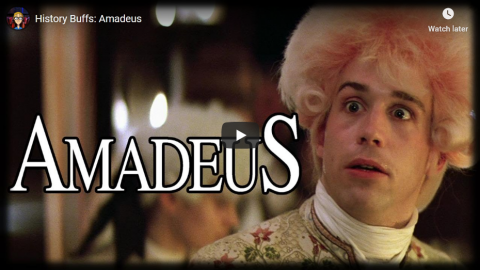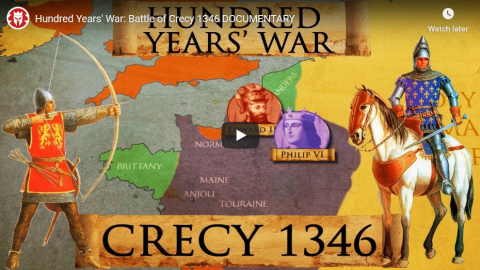History Buffs
Published 3 Dec 2015In this episode we look at the original Rock n Roll bad boy, Wolfgang Amadeus Mozart! And who says this show isn’t classy and sophisticated

● Follow us on Twitter: https://twitter.com/HistoryBuffs_
_________________________________________________________________________
Amadeus is a 1984 American period drama film directed by Miloš Forman, written by Peter Shaffer, and adapted from Shaffer’s stage play Amadeus (1979). The story is set in Vienna, Austria, during the latter half of the 18th century.
The film was nominated for 53 awards and received 40, including eight Academy Awards (including Best Picture), four BAFTA Awards, four Golden Globes, and a Directors Guild of America (DGA) award. In 1998, the American Film Institute ranked Amadeus 53rd on its 100 Years… 100 Movies list.
The story begins in 1823 as the elderly Antonio Salieri (F. Murray Abraham) attempts suicide by slitting his throat while loudly begging forgiveness for having killed Wolfgang Amadeus Mozart (Tom Hulce) in 1791. Placed in a lunatic asylum for the act, Salieri is visited by Father Vogler (Richard Frank), a young priest who seeks to hear his confession. Salieri is sullen and uninterested but eventually warms to the priest and launches into a long “confession” about his relationship with Mozart.
January 15, 2020
History Buffs: Amadeus
“Subdivisions”
Colby Cosh on the way Rush responded to the “New Wave” on their 1982 album Signals:
Every Rush fan is presenting his own list of essential tracks this week: unexpectedly I found myself returning over and over again to “Subdivisions,” the opener from Signals (1982). No Rush song ever had a more portentous dividing effect: there are still fans who haven’t forgiven. Moving Pictures had come out in February of 1981, and its sales set up the band for life and beyond. But it was a consciously backward-looking record — the cover is a big clue — and a culmination of Rush’s original identity. Moving Pictures is an affectionate farewell to 11-minute track lengths and science-fiction song lyrics (mostly).
After just a few months came the first 51 seconds of “Subdivisions” — Rush’s own astonishing riposte to the New Wave. A lone synthesizer pulses (in 7/8) for a few seconds and then Neil comes in: no further description is possible or necessary. The passage would make a career calling card for any drummer, but what was novel was the upside-down structure of the song, with Alex Lifeson’s guitar showing up late and then carrying the rhythm (beautifully, if you take the trouble to pick him out) while the drums truly lead the way. This is rare, outside of a drum-solo setting, for any rock drummer not named Moon or Bonham.
It was as if Rush, until then a very loud group fuelled by metaphors of battle, had made a conscious decision to cool down and give the spotlight to its ultimate weapon. Very well, the start of Signals announced, this is the age of the synthesizer and we’re going along with it — but let’s see you S.O.B.s synthesize Neil Peart.
Not coincidentally, Peart’s lyrics for “Subdivisions” also took an artistic step: they shake free of the SF/fantasy tropes and the 1930s poetic conceits he had mostly hidden behind until then. Heard in 2020, the song drags the mind of the listener helplessly back to the moment when “Subdivisions” was on the radio, yet seems to have been written for us to hear now. “Some will sell their dreams for small desires,” Peart warned in a mood of cranky prophecy, “or lose the race to rats …”.
Hundred Years’ War: Battle of Crecy 1346
Kings and Generals
Published 7 December 2017The Hundred Years’ War of 1337-1453 between France and England is one of the most crucial conflicts in the history of Europe. It changed the social, political and cultural outlook of the countries involved, influenced the change in warfare, brought the end of feudalism closer. The first phase of this war is called the Edwardian War, and one of the most decisive engagements of this conflict was the battle of Crecy (1346). This series will have 5 videos, so don’t hesitate to like, subscribe and share. And if you want to support us, you can do it on Patreon: http://www.patreon.com/KingsandGenerals or Paypal: http://paypal.me/kingsandgenerals
We are grateful to our patrons, who made this video possible: Ibrahim Rahman, Koopinator, Daisho, Łukasz Maliszewski, Nicolas Quinones, William Fluit, Juan Camilo Rodriguez, Murray Dubs, Dimitris Valurdos, Félix Gagné-Dion, Fahri Dashwali, Kyle Hooton, Dan Mullen, Mohamed Thair, Pablo Aparicio Martínez, Iulian Margeloiu, Chet, Nick Nasad, Jeyares, Amir Eppel, Thomas Bloch, Uri Sternfeld, Juha Mäkelä, Georgi Kirilov, Mohammad Mian, Daniel Yifrach, Brian Crane, Muramasa, Gerald Tnay, Hassan Ali, Richie Thierry, David O’Hare, Christopher Commins, Chris Glantzis, Mike, William Pugh, Stefan Dt, indy, Bashir Hammour, Mario Nickel, R.G. Ferrick, Moritz Pohlmann, Russell Breckenridge, Jared R. Parker, Kassem Omar Kassem, AmericanPatriot, Robert Arnaud, Christopher Issariotis, John Wang, Joakim Airas, Nathanial Eriksen and Joakim Airas.
This video was narrated by our good friend Officially Devin. Check out his channel for some kick-ass Let’s Plays. https://www.youtube.com/user/Official…
The Machinimas for this video is created by one more friend – Malay Archer. Check out his channel, he has some of the best Total War machinimas ever created: https://www.youtube.com/user/Mathemed…
Inspired by: BazBattles, Invicta (THFE), Epic History TV, Historia Civilis and Time Commanders
Machinimas made on the Total War: Attila engine using the great Medieval Kingdoms mod.
Production Music courtesy of Epidemic Sound: http://www.epidemicsound.com
QotD: Louis XIV and the first accurate maps of France
In our current age of apps, able to tell us exactly where we are in the world at any time, it’s hard to imagine an era in which most people would never have seen a map. The average English person of the mid-sixteenth century would have had little idea of the overall shape of their own country, let alone a foreign one. And even the merchants and elites who did have access to maps did not have an entirely accurate picture. Before the systematic adoption of trigonometric surveying, as well as the ability to accurately calculate longitude by observing Jupiter’s moons using telescopes, the process involved a lot of guesstimation. When the new techniques were introduced towards the end of the seventeenth century, the results could come as quite a shock. Louis XIV, when shown a revised map of his country, allegedly remarked that he had lost more land to his astronomers than to his enemies. France was a lot thinner than everyone had supposed.
Anton Howes, “The House of Trade”, Age of Invention, 2019-11-13.






